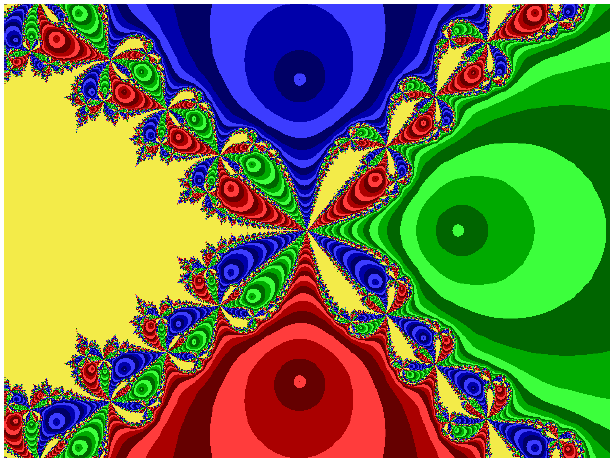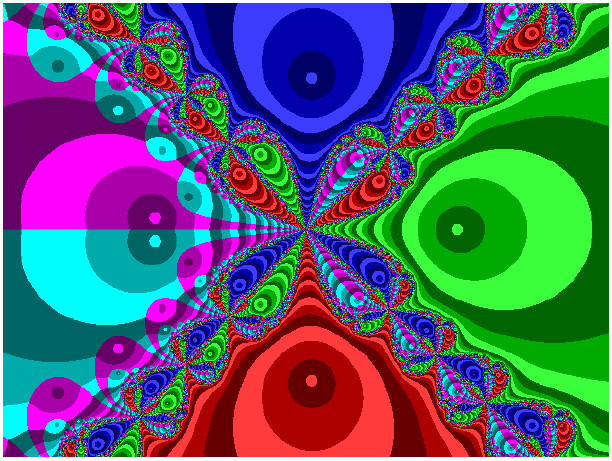Nils B. Lahr
128 Elliott Drive, Menlo Park, CA 94025 USA
Clifford A. Reiter
Department of Mathematics, Lafayette College, Easton PA, 18042 USA
Abstract -- Newton's method for finding complex
solutions of the equation zα −1 = 0 is
investigated for real values of α. The bifurcations that occur as the power α
varies are illuminated
using computer graphics. In particular, the appearance of an attracting 2-cycle
just below even
powers is investigated .
Keywords
Visualization - Chaos - Newton's method
Introduction
Computer graphics allows the visualization of the dynamics of iteration in
powerful ways. Pictures
of bifurcations of functions of a real variable and of basins of attraction for
complex dynamics play
an important role in understanding the dynamics of both real and complex
iteration — from period
doubling to chaos; for examples, see [1-5, 9-12, 14]. This short note describes
bifurcations in the
complex dynamics of Newton's method that we can visualize using a sequence of
images.
Visualizing the convergence of Newton's method in the
complex plane has been the subject
of much recent study. Often those images show the basins of attraction of
Newton's method applied
to a polynomial of low degree . Typically, a family of third degree polynomials
is considered or
zn −1 for n equal to 3, 4 or 5 is considered. Also, in [8] Newton's method on
systems with 2
complex variables is considered. In [15] nonintegral exponents are considered
and in [13] a
generalization of Newton's method is discussed. The dynamics of direct iteration
of zα + c for
fractional exponents , which generalize the classical Mandelbrot and Julia sets,
are described in [6]
and are analyzed in [7]. Instead of direct iteration, we consider the
bifurcations that occur using
Newton's method on zα −1 as we vary α .
Consider the basins of attraction for the roots of z3 −1
compared to those for z4 −1. The
first has three main basins of attraction around the three roots of unity with
symmetric turbulence on
the boundaries. The second case is quite similar except it contains four basins
of attraction. In
general, we expect that slight changes to α should produce only slight changes
in the behavior of
Newton's method on zα −1. However, it is clear that some fundamental changes in
behavior must
occur as we change from three to four basins of attraction. Thus, the question
of how the change
from three to four basins occurs is of interest. How many basins of attraction
are there for any given
positive real α? Does every starting guess converge to a root? Where do the
bifurcations occur?
This paper takes a look at those questions. Figs. 1-8 show the convergence of
Newton's method on
zα −1 for 3 ≤α ≤ 5 . Fig. 1 shows three basins of attraction and Fig. 5 shows
four basins of
attraction as described above.
The Computation
Newton's method for solving f (z) = 0 begins with an initial guess
 and proceeds via:
and proceeds via:
 . Here the function is f (z) = zα −1 so this simplifies into
. Here the function is f (z) = zα −1 so this simplifies into
 .
.
Notice that the second version of this formula can be evaluated more quickly
since it involves only
one power of a complex number. Also notice we can think of steps of Newton's
method as iteration
of the function
 where
where
 .
.
In all the figures the initial guess
 used for Newton's method corresponds to position in the
used for Newton's method corresponds to position in the
picture and varies with
 and
and
 .
The color used indicates the
.
The color used indicates the
basin of attraction and the shade indicates the iteration count modulo 3. For
example, all the shades
of green indicate convergence to the root 1. The shades are chosen so that when
we are within the
green basin we are moving in the direction of increasing iteration count if we
move from the darkest,
through the medium, and to the lightest shade.
All the images were computed with extended precision
floating point arithmetic using 19-20
significant digits and using high precision exponents so that the range of
magnitudes is
 .
.
Complex exponentiation was implemented using the standard branch cut along the
negative real
line . A sequence,
 , was considered convergent if successive values differed by less than
, was considered convergent if successive values differed by less than
 in
in
magnitude. The roots were dynamically determined with a distance of
discrimination of
 . The
. The
roots and 2-cycles discovered can be independently verified as described in the
next section.
Results
In Fig. 1 we see three symmetric basins of attraction that are expected when
α = 3 since the roots of
z3 −1 are the three roots of unity. In Fig. 2, α = 3.3 and the turbulent region
between the left-most
basins increases in size. Notice also that unlike the case when α = 3 there are
boundaries between
the red and blue basins where there is no turbulence (look at some of the small
red and blue regions
near the negative real axis).
In general the equation zα −1 = 0 will have roots
 where k are integers so that
where k are integers so that
2πk /α is in the interval (−π ,π ] . That is, if k ranges over the integers
satisfying
−α / 2 < k ≤α / 2 the values for z given above run through the roots. The three
roots that are
observed when α = 3.3 correspond to k = 0, ±1. These are 1 and approximately −
0.327 ± 0.945i .
The roots for other α's can also be computed this way.
When we increase α to α = 3.88221 there are still only
three roots but there is severe
turbulence. The V-shaped turbulent region between the primary red and blue
regions seen in Fig. 3 is
larger than that in Fig. 2 and almost forms a "basin" of its own. In the first
two figures the maximum
number of iterations required for convergence was 66. In this figure the maximum
number of
iterations required for determining any pixel was 152,931. However, for every
pixel computed the
algorithm did eventually converge to one of the three roots!
A striking bifurcation occurs with a very slight increase
to α = 3.88222 . Fig. 4 shows three
basins of attraction in red, green and blue and a large region in yellow where
Newton's method does
not converge. However, in this region, Newton's method approaches an attractive
2-cycle. In the
long term, values shown in yellow oscillate between values close to r =
−0.883623 + 0.154366i
and s = −0.883623 − 0.154366i . No pixel required more than 1855 iterations to
converge to a root
or to find the 2-cycle in this figure.
Using MathematicaTM it is easy to check numerically that
r and s are 2-cycles since they are
roots to the equation h(z) = z where α = 3.88222 , h(z) = g(g(z)) , and g(z) was
defined in the
previous section. Now the fact that this is an attractive 2-cycle can be
verified since
 and likewise for s. Going back to the case when α = 3.88221 we
can find roots
and likewise for s. Going back to the case when α = 3.88221 we
can find roots
to h(z) = 0 given approximately by u = −0.881416 + 0.154395i and v = −0.883228 −
0.156458i ;
notice the roots u and v are not quite conjugates. These roots also form a
2-cycle, but the 2-cycle is
just barely repelling since
 and likewise for v. The fact
that this derivative is just
and likewise for v. The fact
that this derivative is just
barely over one explains why such a large number of iterations were required for
computing some
pixels in Fig. 3.
The appearance of an attractive 2-cycle continues as α increases toward 4 but
the points in
the 2-cycle approach each other and the negative real axes. At α = 4 , shown in
Fig. 5, these points
meet at -1 and form an attractive basin shown in magenta. Any small increase in
α produces yet
another basin of attraction. In Fig. 6, where α = 4.1, a cyan basin of
attraction is conjugate to the
magenta basin. Notice that there is no turbulence on the negative real axis
which is a boundary
between these basins. Also notice the fractal cyan and magenta "arches". As α
increases turbulence
does appear on the negative real axis. At first it is restricted to inside the
unit circle. Between
α = 4.7 and α = 4.8 the turbulence moves out along the negative real axis. Fig.
7 shows the basins
of attraction when α = 4.8. Notice that there is almost a five-fold symmetry.
Finally, the expected
five-fold symmetry appears in Fig. 8 where α = 5.
In Fig. 9, the angle of the long term behaviors is shown verses the power α for
1 ≤α ≤ 11.
The angle is the angle about the origin from the positive real axis. Attractive
roots are shown in blue
and attractive 2-cycles are shown in green. Notice that just before α equals
each even integer there is
an attractive 2-cycle. The points in the 2-cycle become less distinct and
approach -1; that is, the
angles approach ±π . At the even integer, the 2-cycle has become the new root at
-1. As soon as α
increases beyond the even integer, the root at -1 splits into two attractive
roots. These roots move
apart as α increases and become uniformly spaced around the unit circle when α
reaches the next
higher odd integer. The most striking feature in this figure is the sudden
appearance of the attractive
2-cycles. The first few values of α where these bifurcations occur can be
computed: 1.8163832,
3.882214033, 5.893141755, and 7.897747821.
The sequence of images in this paper shows chaotic behaviors not usually seen in
images of
the convergence of Newton's method. The intertwining basins with smooth
boundaries observed
just above α = 4 are a result of the branch cut used in computing the complex
exponential function.
Those smooth boundaries do not occur for Newton's method on zn −1 with integer
exponents.
There are also fascinating bifurcations that occur just below even integers.
Attractive 2-cycles
appear for those exponents. The changeover of a 2-cycle from repelling to
attractive near
α = 3.88221 can be analyzed as well as observed visually.
Authors' biographies
Nils B. Lahr is a mathematics major at Lafayette College. He is interested in
computer
programming, computer graphics and data base design. He writes seismological
software for the
IASPEI Software Company in Menlo Park CA. He plans to attend graduate school in
mathematics
and computer science.
Clifford A. Reiter is an associate professor of mathematics at Lafayette
College. He received his
PhD in mathematics from Pennsylvania State University in 1984. He is interested
in the use of
computers for insight into mathematical problems with special interest in number
theory, numerical
analysis and visualization. He is coauthor of the text APL with a Mathematical
Accent.

Figure 1: Newton's method on z3 −1.

Figure 2: Newton's method on  .
.

Figure 3: Newton's method on  .
.

Figure 4: Newton's method on  .
.

Figure 5: Newton's method on z4 −1 .

Figure 6: Newton's method on  .
.

Figure 7: Newton's method on  .
.

Figure 8: Newton's method on z5 −1.

Figure 9: Angle of long term behavior of Newton's method on zα −1 for 1 ≤α ≤ 11.



